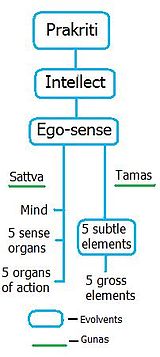Prakṛti
Prakṛti, also Prakriti or Prakruti (from Sanskrit language प्रकृति, prakṛti), means "nature".[1][2] It is a key concept in Hinduism, formulated by its Samkhya school, and refers to the primal matter with three different innate qualities (Guṇas) whose equilibrium is the basis of all observed empirical reality.[1][3] Prakriti, in this school, contrasts with Purusha which is pure awareness and metaphysical consciousness.[1] The term is also found in the texts of other Indian religions such as Jainism,[4] and Buddhism.[5]
In Indian languages derived from Indo-European Sanskrit roots, Prakriti refers to the feminine aspect of all life forms, and more specifically a woman is seen as a symbol of Prakriti.[6]
Etymology and meaning[edit]
Prakriti (Sanskrit: प्रकृति) is a Vedic era concept, which means "making or placing before or at first, the original or natural form or condition of anything, original or primary substance."[7] The term is discussed by Yāska (~600 BCE) in Nirukta, and found in numerous Hindu texts.[7] It connotes "nature, body, matter, phenomenal universe" in Hindu texts.[6][8]
Discussion[edit]
In the Samkhya school, it is contrasted with Purusha (spirit, consciousness),[9] and Prakriti refers to "the material world, nature, matter, physical and psychological character, constitution, temper, disposition".[7] According to Knut Jacobsen, in the dualistic system of the Samkhya school, "Purusha is the principle of pure consciousness, while Prakriti is the principle of matter", where Purusha is the masculine in every living being as consciousness, while Prakriti is the feminine and substrate which accepts the Purusha.[6]
In Hindu mythologies, Prakṛti is the feminine aspect of existence, the personified will and energy of the Supreme (Brahman); while in Shaktism, the Goddess is presented as both the Brahman and the Prakṛti.[7] In Samkhya-Yoga texts, Prakriti is the potency that brings about evolution and change in the empirical universe. It is described in Bhagavad Gita as the "primal motive force".[9] It is the essential constituent of the universe and is at the basis of all the activity of the creation.[10]
Prakriti is closely associated with the concept of Maya (Prakrti Love Sangay or vice-versa) within Hindu texts.[11]
In Jainism the term Prakriti is used in its theory of Karma, and is considered "that form of matter which covers the perfections of the soul (jiva) and prevents its liberation".[12]
According to Samkhya and the Bhagavad Gita Prakrti or Nature is composed of the three gunas which are tendencies or modes of operation, known as rajas (creation), sattva (preservation), and tamas (destruction). Sattva encompasses qualities of goodness, light, and harmony.[13] Rajas is associated with concepts of energy, activity, and passion; so that, depending on how it is used, it can either have a supportive or hindering effect on the evolution of the soul.[14] Tamas is commonly associated with inertia, darkness, insensitivity.[15] Souls who are more tamasic are considered imbued in darkness and take the longest to reach liberation.[16]
See also[edit]
References[edit]
- ^ a b c James G. Lochtefeld (2001), The Illustrated Encyclopedia of Hinduism: A-M, Rosen Publishing, ISBN 978-0823931798, Pages 224, 265, 520
- ^ Esoteric anatomy: the body as consciousness By Bruce Burger, (North Atlantic Books : 1998) Page 168
- ^ Prakriti: Indian philosophy, Encyclopædia Britannica
- ^ J Jaini (1940). Outlines Of Jainism. Cambridge University Press. pp. 32–33. GGKEY:B0FNE81JRLY.
- ^ Paul Williams (2005). Buddhism: Yogācāra, the epistemological tradition and Tathāgatagarbha. Routledge. p. 20. ISBN 978-0-415-33231-6.
- ^ a b c Knut A. Jacobsen (2008). Bron Taylor, ed. Encyclopedia of Religion and Nature. Bloomsbury Academic. pp. 1299–1300. ISBN 978-1-4411-2278-0.
- ^ a b c d Monier Monier-Williams (1899), Monier William's Sanskrit-English Dictionary, 2nd Ed., Oxford University Press, Prakriti प्रकृति, page 654
- ^ Constance Jones; James D. Ryan (2006). Encyclopedia of Hinduism. Infobase Publishing. pp. 332–333. ISBN 978-0-8160-7564-5.
- ^ a b Charles Johnston (2014). The Bhagavad Gita: Songs of the Master. pp. 159 footnote 36. ISBN 978-1-4904-5140-4.
- ^ Maharishi Mahesh Yogi on the Bhagavad-Gita, a New Translation and Commentary, Chapter 1-6. Penguin Books, 1969, p. 220
- ^ https://books.google.com/books?id=rAorcEA7j4QC&pg=PA40&dq=Prakriti++maia&lr=&ei=vdbwSY_oNor0ygTsq_ieCw Preceptos de Perfección, Discípulos de Ramakrishna, p 40.
- ^ Knut A. Jacobsen (1999). Prakr̥ti in Samkhya-yoga: Material Principle, Religious Experience, Ethical Implications. Peter Lang. pp. 151–162. ISBN 978-0-8204-3465-0.
- ^ Eknath Easwaran (2007). The Bhagavad Gita. Nilgiri Press. pp. 221–. ISBN 978-1-58638-023-6.
- ^ https://books.google.com/books?id=a-Oh_-rK5SQC&pg=PA221&dq=prakriti&lr=&ei=v3_zSdPwI4W-NsqwscEJ&hl=En The Bhagavad Gita, Eknath Easwaran, P.221., 2007.
- ^ id
- ^ The Concise Yoga Vāsiṣṭha, Swami Venkatesananda, 1984, p.94
External links[edit]
| Wikiquote has quotations related to: Prakṛti |
- Bhagavad Gita 13.1-2 (bhagavadgitaasitis.com)
- Prakrti and Ayurveda
